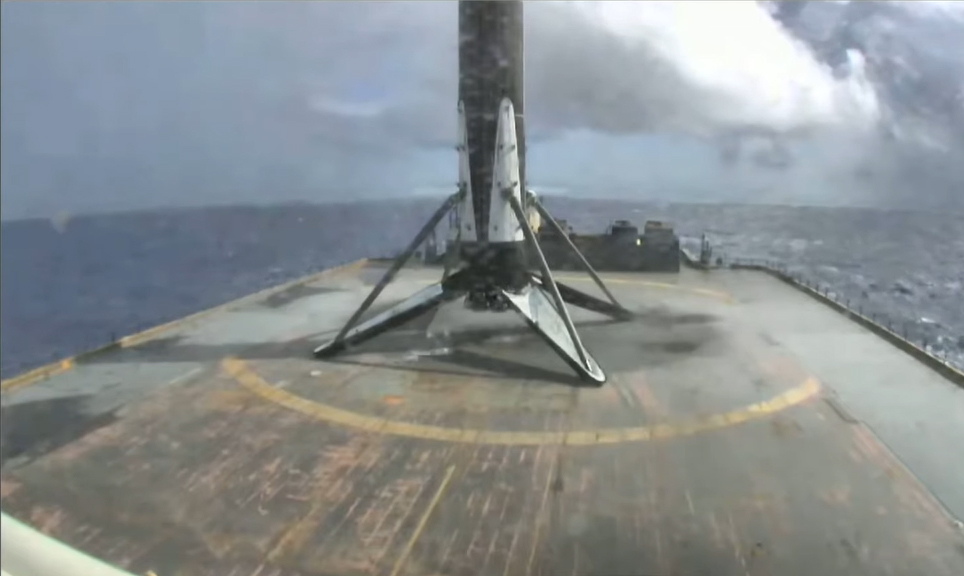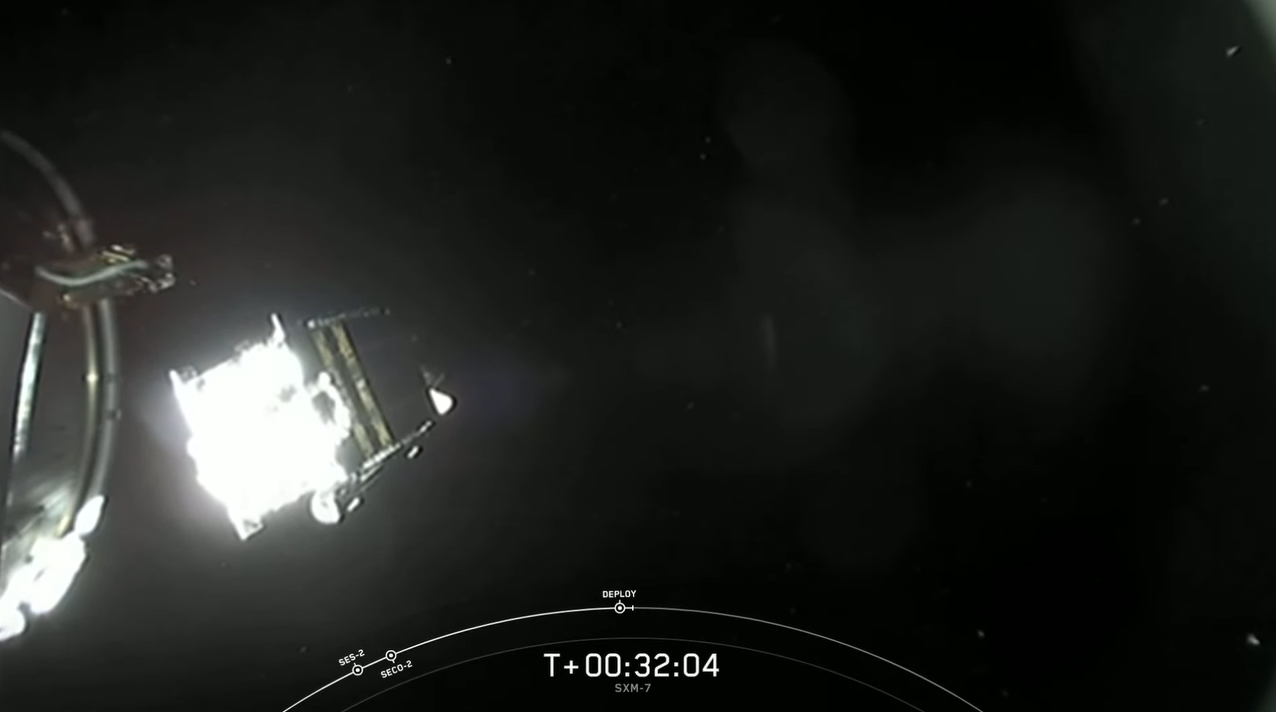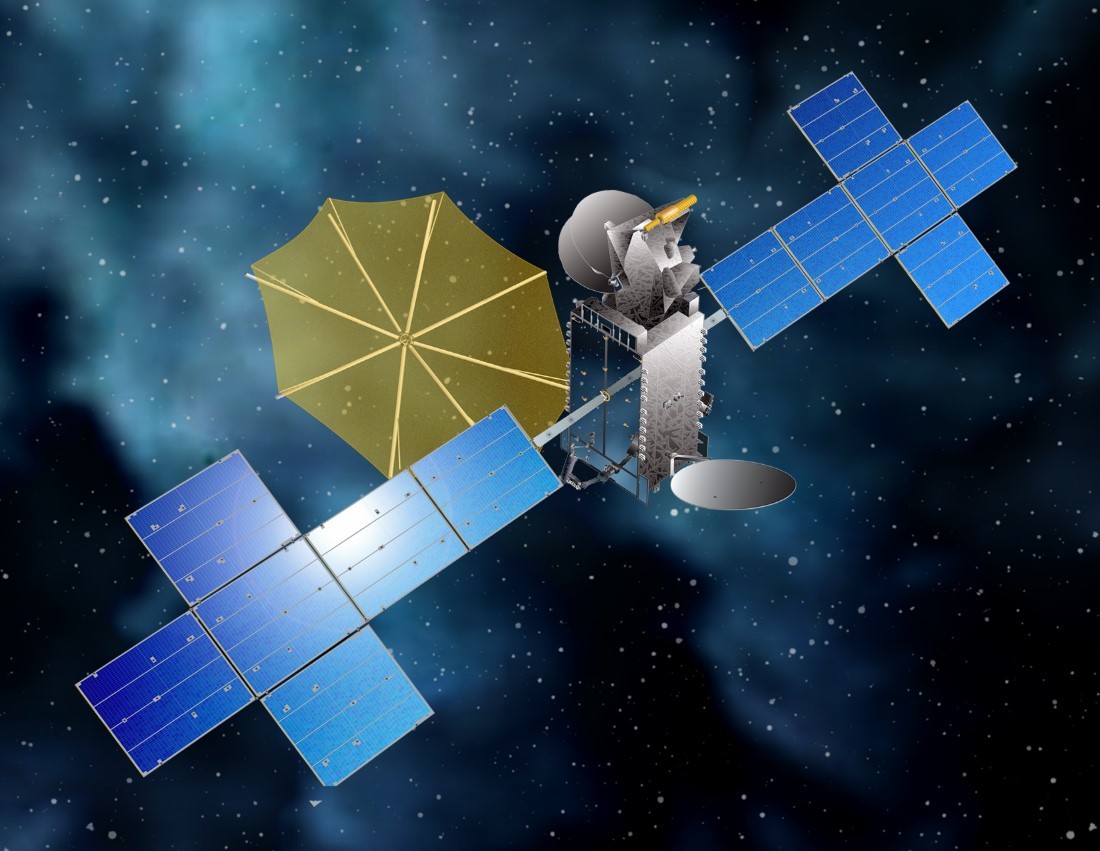SpaceX just launched a powerful Sirius XM satellite into orbit and nailed a rocket landing
It was the seventh launch and landing for the Falcon 9 rocket.
CAPE CANAVERAL, Fla. — SpaceX launched a veteran Falcon 9 rockets on its seventh trip to space Sunday (Dec. 13) to carry a massive radio satellite into orbit for Sirius XM and then return to Earth.
The two-stage Falcon 9 rocket blasted off at 12:30 p.m. EDT (1730 GMT) from Space Launch Complex 40 hereat Cape Canaveral Space Force Station , marking the company's 25th launch of the year. It carried the SXM-7 next-generation radio satellite into orbit for customer Sirius XM.
Approximately 9 minutes later, the booster's first stage returned to Earth, landing on the SpaceX drone ship "Just Read The Instructions" in the Atlantic Ocean. The launch occurred midway through a planned two-hour window (it was originally slated for 11:22 a.m. EST) to await good weather conditions for both the launch and booster landing, SpaceX representatives said via Twitter.
Related: See the evolution of SpaceX's rockets in pictures
The mission was originally planned to blast off Friday (Dec. 11), less than 24 hours after a United Launch Alliance Delta IV Heavy launched a massive spy satellite for the U.S. government from a nearby pad.
The turnaround time between the two launches would have been just over 15 hours, marking the shortest time between launches here at the Cape since the 1960's. In September 1967, a Delta-G and Atlas-Centaur took off from two different launch pads 10-hours apart. Last August, a Falcon 9 and an Atlas V rocket launched within 35 hours of each other, a first since May 1981.
But on Friday, SpaceX scrubbed the launch attempt following multiple delays within the planned flight window. During the final minutes of the countdown, SpaceX called a hold and ultimately stood down from that attempt, citing the need for additional ground systems checkouts. The delay proved fruitful as the veteran Falcon 9 rocket leapt off the pad on Sunday for its 7th mission.
Breaking space news, the latest updates on rocket launches, skywatching events and more!
Another frequent flyer
For this mission, the 230-foot-tall (70 m) Falcon 9 successfully delivered the high-powered radio broadcasting satellite Sirius XM-7 (SXM-7) into orbit. Built by Maxar Technologies for Sirius XM, it's one of two satellites to be launched by SpaceX to replace outdated ones currently on orbit.
The rocket’s first stage booster, now with seven launches and landings under its belt, touched down on SpaceX's "Just Read the Instructions" drone ship, which was waiting in the Atlantic. It marks the 69th recovery of a first stage booster for the California-based rocket manufacturer.
The rocket featured in Sunday's launch is another record-setting booster. Known as B1051, this flight proven booster embarked on its seventh flight — the second of SpaceX's fleet to do so. The first, B1049, ferried a batch of 60 Starlink satellites into orbit on Nov. 24, before touching down on the company’s other drone ship, “Of Course I Still Love You”.
To date, B1051 has carried an uncrewed Crew Dragon spacecraft to the International Space Station as part of a 2019 flight test, followed by a trio of Earth-observing satellites for Canada as well as four different Starlink missions. For it's 7th flight, it ferried a 15,432-lb. (7,000-kg) satellite into orbit for Sirius XM. The satellite will beam down more than 8,000 watts of content to Sirius subscribers across the U.S., Canada and the Caribbean.
The SXM-7 satellite is based on Maxar Technologies' SSL-1300 satellite bus. It's outfitted with two large solar arrays as well as batteries for on-orbit storage. SXM-7 will operate in the S-band spectrum, between 2.32 GHz and 2.345 GHz and is part of a pair that SpaceX is launching for Sirius XM.
SpaceX is contracted to launch another satellite for Sirius XM, called SXM-8, which is slated to launch next year. Each satellite has an operational lifetime of 15 years, and will replace two aging satellites already on orbit.
The launch of Sirius XM's SXM-7 satellite caps a busy week for the Cape and for SpaceX.
On Dec. 6, SpaceX launched its first upgraded Cargo Dragon spacecraft from Pad 39A at NASA's Kennedy Space Center. The automated cargo ship arrived at the International Space Station on Dec. 7, and successfully docked itself to the space station for the first time. (Its previous iteration was berthed to the orbital outpost with the help of the station's robotic arm.)
Meanwhile, the company launched a prototype of its Starship Mars rocket on a high-altitude test flight on Wednesday (Dec. 9). The 164-foot-tall (50 m) prototype rocket flew to an altitude of 7.7 miles (12.5 km) and was the first prototype to be powered by three of SpaceX's methane-fueled Raptor engines. The stainless steel ship then performed a guided descent back toward a landing pad at SpaceX's test facility in Boca Chica, Texas, located near the border between the U.S. and Mexico.
As part of its test flight, the Starship rocket performed a dramatic flip maneuver, which set itself up for landing, after the massive rocket did a mid-air belly flop, which sent it racing back to Earth. The rocket landed too hard, erupting in a dramatic fireball. Company founder and CEO, Elon Musk, hailed the test flight as a smashing success, saying teams got the data they needed.
Musk and SpaceX are building the reusable Starship as a means to eventually carry massive amounts of cargo into space, and to transport people to the moon, Mars and beyond.
To prepare for this flight, SpaceX test-fired the veteran booster on Monday evening (Dec. 7), then transported the rocket back into the hangar to be mated with its payload.
This flight marks the first time that a paying customer will fly on such a veteran rocket. Historically, SpaceX has reserved first stage boosters with more than three flights under their belts for its own Starlink missions. This could be a promising sign that companies are trusting the reusability factor and are more comfortable with these tried-and-true boosters.
It also marks the first time that SpaceX is flying a used piece of a payload fairing for a paying customer. The company has been amping up its reusability efforts to include more of the rocket. On this particular mission, one of the pieces of the protective nose cone flew on the Anasis-II flight this summer.
To facilitate this type of reuse, SpaceX has two boats that are outfitted with giant nets. These boats, named GO Ms. Tree and GO Ms. Chief, are able to catch fairing pieces as they fall back to Earth or scoop them out of the ocean and bring them back to port to be used again.
A few days before launch, GO Ms. Tree was deployed to the recovery zone. The net-equipped vessel is working solo this mission as GO Ms. Chief is still stationed at Port Canaveral.
Up next for SpaceX is the launch of a classified satellite for the National Reconnaissance Office. That mission is scheduled to lift off from NASA's historic Pad 39A at Kennedy Space Center on Thursday, Dec. 17.
Follow Amy Thompson on Twitter @astrogingersnap. Follow us on Twitter @Spacedotcom or Facebook.

Amy Thompson is a Florida-based space and science journalist, who joined Space.com as a contributing writer in 2015. She's passionate about all things space and is a huge science and science-fiction geek. Star Wars is her favorite fandom, with that sassy little droid, R2D2 being her favorite. She studied science at the University of Florida, earning a degree in microbiology. Her work has also been published in Newsweek, VICE, Smithsonian, and many more. Now she chases rockets, writing about launches, commercial space, space station science, and everything in between.




